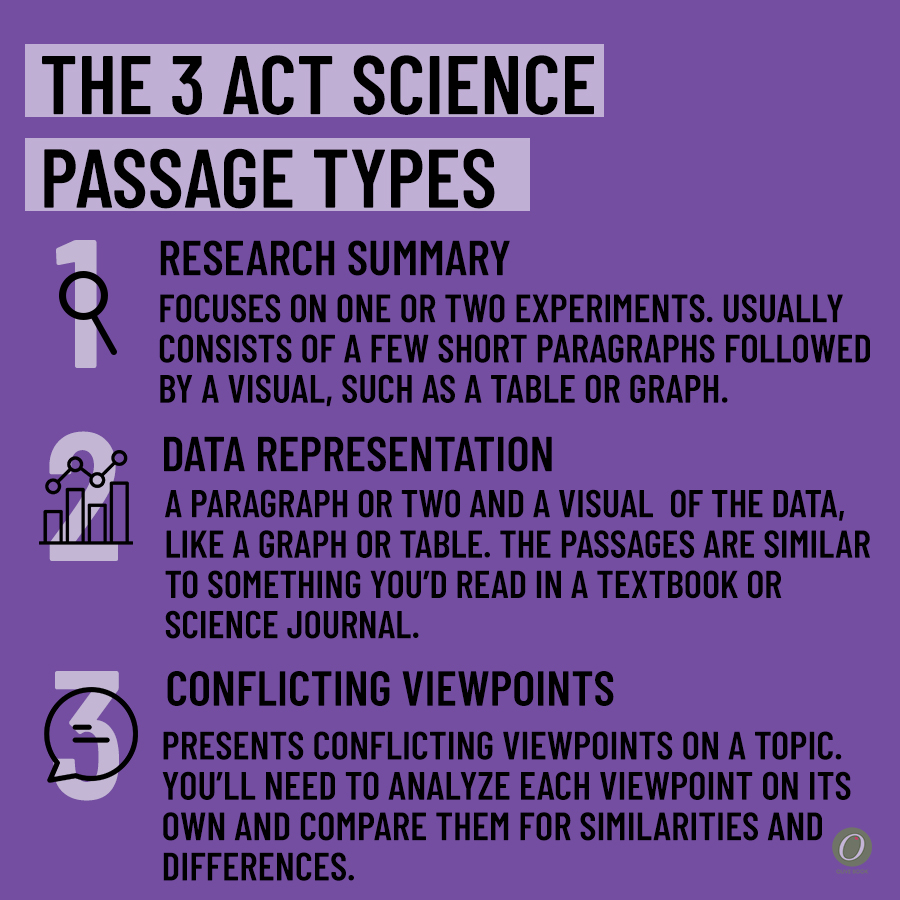Unless you’ve taken the ACT before, you probably haven’t encountered too many science writings in your everyday reading. What types of passages are on the ACT Science section? What can you expect from the Science passages?
We’re covering the three kinds of ACT Science passages you’ll see on the test and some quick strategies for each passage type.
How Many Passages are on the ACT Science Section?
There are about six passages on the ACT Science section. (There have been seven in the past, but more recently there have only been six passages on the test. The ACT does not have an official statement about the number of Science section passages).
Of the six passages, you will see three kinds of passages: Research Summary, Data Representation, and a Conflicting Viewpoints passage. There are usually three Research Summary passages, two Data Representation passages, and one Conflicting Viewpoints passage.
How is the ACT Science Section Structured?
Research Summary Passages
The Research Summary passages focus on one or two experiments. They usually consist of a few short paragraphs followed by a visual, such as a table, graph, or experimental set up. The passage focuses on the experiment, and the questions focus on the results, interpretations, or design of the experiment.
To do well on these questions, you need to understand scientific investigation and experimental design. After reading the passage and before going to the questions, ask yourself, “What is the purpose of this experiment?”
Data Representation Passages
Similar to the Research Summary passages, in the two Data Representation passages you’ll encounter a paragraph or two and a visual representation of the data, like a graph or table. The passages are similar to something you’d read in a textbook or science journal. The Data Representation questions may require you to do calculations or to interpret trends.
Read these passages quickly, but pay close attention to the labels on the graphs and figures, looking for relationships. Ask yourself, “What is the main idea or trend of this chart (or table or graph)?”
5 Strategies for Reading Tables and Graphs
The Conflicting Viewpoints Passage
The Conflicting Viewpoints passage presents conflicting viewpoints on a topic. The viewpoints may agree on some points and disagree on others. You’ll need to analyze each viewpoint on its own and compare them for similarities and differences.
We find it helpful to pretend that these viewpoints represent two or more people having a debate. On what parts of the topic would they agree? On what parts would they disagree?
Strategies for Reading the ACT Science Passages
You actually do want to read the passages (quickly) before beginning the questions. By quickly reading the passages, hopefully, you will save yourself from having to return to the passage for every single question.
But unlike the Reading section, when you can spend some more time on each passage, you want to skim the science passages and data as quickly as you can with the goal of “noting” things.
Think, “What does this show?” (especially for graphs) and “Why are they telling me this?”
Strategies for the ACT Science Section
You are not trying to completely understand the passage, diagrams, or the charts/graphs. Your goal is to note things — so in your mind you might say, “Ok, so if they are telling me the supplies for the experiment, they will probably ask me something about this.”
You are not trying to completely understand the passage, diagrams, or the charts/graphs. Your goal is to note things — so in your mind you might say, “Ok, so if they are telling me the supplies for the experiment, they will probably ask me something about this.”
But you are not looking through the list carefully or thinking you are going to remember them all. You need to know generally what the passage is about — like if you were telling a friend, you could say “you know, the one about the different amounts of sugar and energy in foods” — if you can’t summarize it, then you skimmed it too quickly!
Studying for the ACT Science Section
The best way to prepare for the ACT Science section is to practice. Practicing skimming the passages, noting what’s important, and answering the questions will help you prepare for this fast-paced ACT test section.
Our online ACT course contains nine practice science passages with accompanying questions – plenty to practice! The course also contains diagnostic tests to track your progress and exclusive Science section tips. You can learn more about the course here.
The Three Types of ACT Science Passages
To recap, there are three kinds of ACT Science passages: Research Summary, Data Representation, and a Conflicting Viewpoints passage. There are usually six passages total – usually three Research Summary passages, two Data Representation passages, and one Conflicting Viewpoints passage.
Your goal when reading the passages is to skim quickly while noting important points. Remember to ask yourself “What does this show?” and “Why are they telling me this?”

More Resources:
5 Strategies for Reading Tables and Graphs
Strategies for the ACT Science Section
Graphs to Know for the ACT Science Section
How is the ACT Science Section Structured?
